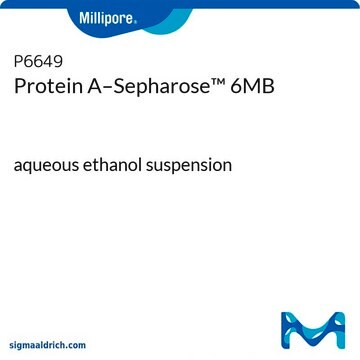16-156
Proteína A-agarosa, flujo rápido
Protein A Agarose, Fast Flow suitable for medium and low-pressure chromatography, immunoprecipitation and antibody purification.
Sinónimos:
Protein A resin
Iniciar sesiónpara Ver la Fijación de precios por contrato y de la organización
About This Item
UNSPSC Code:
41116133
eCl@ss:
32160801
NACRES:
NA.56
Productos recomendados
form
liquid
manufacturer/tradename
Upstate®
technique(s)
affinity chromatography: suitable
immunoprecipitation (IP): suitable
western blot: suitable
shipped in
wet ice
General description
La proteína A es una proteína de unión a inmunoglobulina (Ig) que se utiliza para purificar grandes cantidades de IgG. Se une a la parte Fc del anticuerpo en la interfaz CH2–CH3. La proteína A-agarosa podría ser adecuada para el aislamiento de anticuerpos a baja presión.
Proteína A recombinante acoplada covalentemente a microesferas de agarosa al 6 % muy reticuladas.
Capacidad de adsorción: 40 mg de IgG humana/ml de agarosa
Proteína A recombinante acoplada covalentemente a microesferas de agarosa al 6 % muy reticuladas.
Capacidad de adsorción: 40 mg de IgG humana/ml de agarosa
Application
La proteína A-agarosa, de flujo rápido se ha utilizado en inmunoprecipitación e inmunoprecipitación de cromatina (CHIP).
Quality
evaluada habitualmente en inmunoprecipitación
Physical form
agua destilada estéril que contiene timerosal al 0,01 %
Legal Information
UPSTATE is a registered trademark of Merck KGaA, Darmstadt, Germany
Storage Class
10 - Combustible liquids
wgk_germany
WGK 1
Certificados de análisis (COA)
Busque Certificados de análisis (COA) introduciendo el número de lote del producto. Los números de lote se encuentran en la etiqueta del producto después de las palabras «Lot» o «Batch»
¿Ya tiene este producto?
Encuentre la documentación para los productos que ha comprado recientemente en la Biblioteca de documentos.
Los clientes también vieron
Ghia M Euskirchen et al.
Genome research, 17(6), 898-909 (2007-06-15)
Recent progress in mapping transcription factor (TF) binding regions can largely be credited to chromatin immunoprecipitation (ChIP) technologies. We compared strategies for mapping TF binding regions in mammalian cells using two different ChIP schemes: ChIP with DNA microarray analysis (ChIP-chip)
Simon Schenk et al.
American journal of physiology. Endocrinology and metabolism, 291(2), E254-E260 (2006-05-04)
Although the increase in fatty acid oxidation after endurance exercise training has been linked with improvements in insulin sensitivity and overall metabolic health, the mechanisms responsible for increasing fatty acid oxidation after exercise training are not completely understood. The primary
Lei Jiang et al.
Investigative ophthalmology & visual science, 61(5), 41-41 (2020-05-24)
To identify the pathogenic gene of infantile nystagmus syndrome (INS) in three Chinese families and explore the potential pathogenic mechanism of FERM domain-containing 7 (FRMD7) mutations. Genetic testing was performed via Sanger sequencing. Western blotting was used to analyze protein
Chih-Chin Huang et al.
The Journal of biological chemistry, 284(25), 17206-17215 (2009-04-15)
G protein-coupled receptor (GPCR) kinases (GRKs) phosphorylate activated GPCRs and initiate their desensitization. Many prior studies suggest that activated GPCRs dock to an allosteric site on the GRKs and thereby stimulate kinase activity. The extreme N-terminal region of GRKs is
Yong Cheng et al.
Nature, 515(7527), 371-375 (2014-11-21)
To broaden our understanding of the evolution of gene regulation mechanisms, we generated occupancy profiles for 34 orthologous transcription factors (TFs) in human-mouse erythroid progenitor, lymphoblast and embryonic stem-cell lines. By combining the genome-wide transcription factor occupancy repertoires, associated epigenetic
Nuestro equipo de científicos tiene experiencia en todas las áreas de investigación: Ciencias de la vida, Ciencia de los materiales, Síntesis química, Cromatografía, Analítica y muchas otras.
Póngase en contacto con el Servicio técnico







